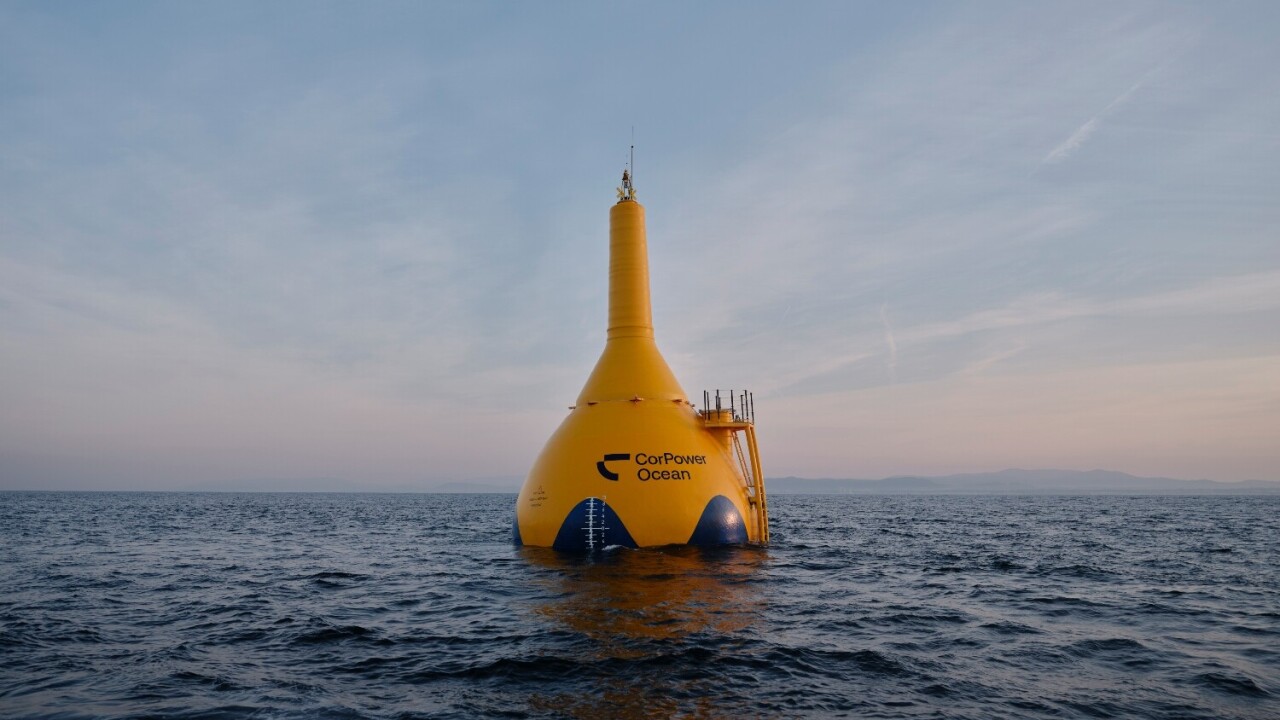
In November 2023, violent Atlantic storm “Domingos” struck the northern coast of Portugal, generating record-high waves and leaving a path of destruction across much of Western Europe.
People on land were grappling with flooded homes, closed roads, and landslides. But just offshore, a potentially game-changing wave energy device was happily bobbing up and down, side to side — seemingly, in its element.
Built by Swedish startup CorPower, the giant golden buoy turns the raw power of the ocean into a clean, reliable electricity source. CorPower claims its tech is at least five times more efficient than the previous state-of-the-art.
“We’ve proven that our technology is both energy efficient and can survive the harshest ocean conditions — two problems that have plagued the industry for decades,” Patrik Möller, Corpower’s co-founder and CEO, tells TNW.
Today, the company announced that it has secured €32mn in funding, history’s largest single investment in a wave energy startup.
In an industry haunted by the ghosts of failed projects, wasted ideas, and bankrupt ventures, has wave energy finally found its golden buoy?

Huge source of baseload energy
In recent years, there has been a surge of interest in wave energy, driven by the need for more reliable sources of clean power.
“Think about wave energy as a buffer of electricity,” Amin Al-Habaibeh, wave energy expert and professor of intelligent engineering systems at Nottingham Trent University, tells TNW.
Energy from waves is available 90% of the time, compared with 20-30% for wind and solar power, and is easy to predict and forecast.
“When the wind isn’t blowing or the sun isn’t shining you still have waves rolling in from thousands of kilometres away, day and night. If we manage to harness this in a commercially viable way, we have a huge source of baseload energy,” says Al-Habaibeh.

In theory, waves carry enough potential energy to power the entire planet. Yet, last year wave energy devices only generated about 1MW of Europe’s total electricity, according to Ocean Energy’s latest report. That’s only enough to supply around 1,000 homes.
CorPower is one of a small but growing number of companies looking to bring wave energy out from the depths and into the ring with renewable heavyweights like solar, wind, and hydro. And the Swedish venture believes its technology has what it takes to do just that.
Tapping the ocean’s rhythm
The inspiration for CorPower’s technology came not from the sea, but from rhythmic beating of the human heart. This vital organ only uses energy when it contracts and pushes blood out and into the body. To suck blood back in, it simply relaxes, pumping blood in two directions from one action.
In 1984, Swedish cardiologist Dr Stig Lundbäck patented the Dynamic Adaptive Piston Pump, a system that replicates the dual-action of the heart. Over the years that followed, the doctor-turned-inventor schemed elaborate ways to put the pump to good use. In 2011, he teamed up with Möller, a tech entrepreneur, and founded CorPower Ocean.
The C4 is a point absorber, a type of floating wave energy device that is anchored to the seafloor and converts the up and down motion of a buoy into electrical power. It measures 18 metres high, 9 metres across, and weighs about 70 tonnes.

As the buoy moves with the waves, a Power Take-Off (PTO) mechanism — a series of springs, gears, and pistons — converts the vertical motion into rotational energy. This then drives a generator, producing power which is transferred to shore via a subsea cable.
When a wave pushes the buoy up, a specially designed “wave spring” stores up pressure in a pneumatic cylinder. When the buoy goes back down, this built up pressure provides a returning force — the C4 captures two forces from one action.
Crucially, C4 uses algorithms to predict the motion of incoming waves, boosting the amount of energy it can harness. When waves get too rough, the AI sends a signal to the power control system telling it to enter “‘storm survivability”’ mode — a de-tuned state comparable to when wind turbines pitch their blades during strong gales.
Over the course of a six-month trial last year, the C4 achieved a maximum power output of 600KW, electricity it exported to the Portuguese grid.
Möller called its first commercial-scale pilot a “massive breakthrough” that tackles two key issues in harnessing this huge untapped clean energy source: efficiency and survivability.
A troubled past
Moored off a harbour in the Orkney islands lies the rusted wreckage of a 180 metre-long wave energy convertor built by Scottish startup Pelamis. In 2004, the giant red sea snake-looking machine became the world’s first grid-connected wave energy device.
The sea snake was a wave energy attenuator, made up of five connected sections that flexed and bent in the waves. Hydraulic rams located in the joints harnessed the movement, driving electrical generators and sending power to the grid via a subsea cable.
Pelamis went on to build several more of the 1,350-tonne behemoths. In 2008, three machines installed off the coast of Portugal were generating enough clean energy to power 1,500 homes.

But the company’s success was short-lived. High installation and maintenance costs, frequent breakdowns, poor efficiency, and a subsequent lack of funding forced Pelamis into administration in 2014. The company’s remaining wave energy converters are now little more than scrap metal.
“Pelamis is largely symbolic of an industry that has struggled with commercial viability,” says Al-Habaibeh.
Frenchman Girard filed the first patent for a wave energy converter back in 1799. Since then, engineers have invented over 1,000 devices, many bearing peculiar names such as the Edinburgh duck, the wave dragon, and the oyster. Most never broke out of the lab.
That’s largely because testing a wave energy device in real-world conditions is incredibly expensive. Building one that can cost-efficiently produce electricity and withstand ocean storms and saltwater corrosion? That’s never been proven over the long term.
The major challenges of harnessing wave power have deterred private investors, with proven renewables like solar and wind constituting safer bets. But there are signs that the tides are turning.
Wave energy investment
In July, the US senate proposed the Marine Energy Bill, which, if passed, would make a record $1bn available for the commercialisation of ocean power technologies like wave and tidal energy converters. In a separate announcement in September, the Biden-Harris administration opened a $112.5mn funding call for wave energy tech.
Europe has invested over €375mn in ocean energy R&D over the past 10 years. While the continent is still the world leader in wave energy, the US and China are catching up fast.
Aside from state grants, there has been a steady trickle of private investments into wave energy startups in recent years.
Finland’s AW Energy has secured a total of $30.5mn (€28mn) for WaveRoller, a fully submerged device that converts ocean wave energy into electricity by using underwater panels that move with the waves.

Mocean Energy secured €2.6mn in November from the likes of Norwegian impact investors Katapult Ocean, bringing its total raised to €13mn. The UK-based company has built a floating hinged raft that captures energy from the relative motion of the two arms as the wave passes them.
Mocean’s CEO, Cameron McNatt told TNW that the company is mainly targeting the oil and gas industry which is looking for cleaner ways to power their offshore equipment. The startup has already completed a year-long testing phase funded by five customers, including Shell and Total Energies, focusing on micro-grid power.
Other promising startups include Denmark’s WavePiston, which converts wave power into electricity by using a series of moving plates, and Israeli firm EcoWave Power, who’s tech attaches to man-made structures on shore, like harbour walls, instead of the seafloor.
Of all of them, CorPower is the best funded, having secured a total of €95mn, mainly from VC and impact investors, since its founding in 2012. And now, armed with fresh funding off the back of a successful trial, it looks to scale — fast.
Scaling up
CorPower now looks to replicate the success of its pilot on a much bigger scale. The startup is now building three more buoys to deploy off the coast of Portugal in 2026, with further plans signed with Irish utility ESB for 14 more devices. Once up and running, this would be the world’s first commercial wave farm.
CorPower’s ultimate goal is to deploy “clusters” of C4s that combined will produce up to 30MW of clean electricity. That’s enough to power around 30,000 homes, while optimising the power output of more variable renewables like wind and solar.
CorPower’s business will only become cost competitive if it can reach a scale of 600MW or more in total deployment. This is where the company predicts its buoys will be able to produce power at a levelized cost of electricity (LCOE) of €71/MWh — what Möller calls the “magic number.”

LCOE measures the total cost of producing energy over a project’s lifetime, helping to determine how competitive it will be in the energy market. In 2024, the LCOE of utility-scale solar PV was €55/MWh.
“We can extract a lot of energy from a relatively small device, and that’s the basis for driving down the cost very quickly,” says Möller.
In pursuit of the magic number, CorPower is taking a nimble, high-tech approach to manufacturing.
The C4’s hull is built by a robot that adds layer upon layer of metal filament to make a lightweight composite structure. CorPower has developed its own fully automated “mobile factory” concept that it plans to use to fabricate the hulls close to the site of each wave farm. The company wants to be able to produce a single hull in just 48 hours.
The buoy is tethered to the seafloor using a specially designed UKMACK anchor that’s about three times lighter than a conventional monopile. It also features a quick-connector system that allows the wave energy converter to be easily connected and disconnected, reducing maintenance costs.
An inflection point in wave energy?
CorPower is now looking to raise fresh funding to fuel its growth. The company is also working with off-takers and large energy consumers to achieve bankability.
Richard Arnold, UK Marine Energy Council (UKMEC) policy director, compared the current position of wave energy to where floating wind was several years ago.
“Everyone started laughing at the early pioneers within floating wind, then suddenly some money came into it and then there were one or two demonstration projects that proved successful,” he said.
“Then suddenly we’re having hundreds of gigawatts [of floating wind] in the world to develop and it happened in a very short time because governments, regulators, product developers, financiers, just agreed, ‘okay let’s do it’.”
CorPower’s tech could be the breakthrough that finally drags wave energy out from the ocean depths and into the mainstream.
Möller says he believes wave energy will eventually become the world’s third largest source of energy, with wind in second, and solar in first place.
Will that come to pass? Only time will tell. But if any of today’s wave energy technologies has a genuine shot, it’s probably the C4.
Get the TNW newsletter
Get the most important tech news in your inbox each week.




